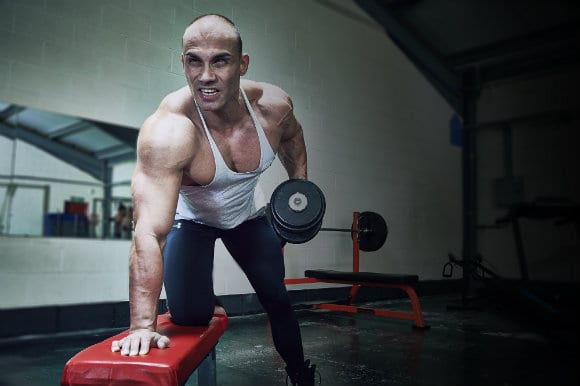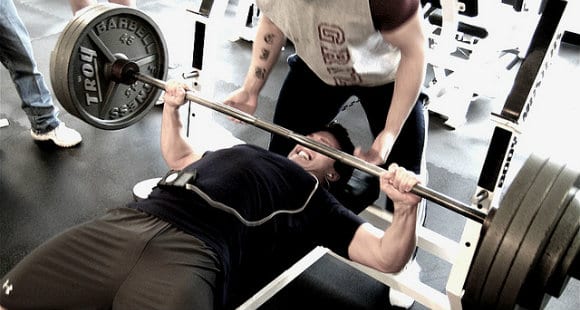By the healthiergang writer Gabriele Corda, personal trainer and federal instructor specializing in fitness and functional training.
Gym Benches: How Many Types?
If the weight room is not new to you, you will have seen the variety of exercises available. Leaving aside the machines, which should be seen one by one and there would still be variations depending on the manufacturer, we can see the amount of benches available.
Straight, inclined, inclinable, curved, are they all the same or are each more suitable for a certain movement?
1. Olympic bench
Let's start with simple things: Olympic or semi-Olympic horizontal bench.
This is the "classic" bench of all weight rooms as well one of the symbols of bodybuilding, unlike mobile benches, it is fixed and has a support for the barbell.
It is the best bench to bench press, not for nothing that Olympic competitions take place on this kind of equipment.
This type of bench is very solid and well placed on the ground, must ensure stability for the athlete so that he feels secure and can concentrate all the effort on the exercise. As mentioned, it is perfect for the bench press exercise but no one forbids it from being used for other exercises such as dumbbell pushes, the tight-grip barbell flat bench or even crosses with dumbbells.
La perfectly horizontal position and the great stability makes it excellent for the development of the chest and thanks to the various supports it allows the use of large loads on the barbell.
2. Inclined bench
If we want to affect the upper chest area more (while remembering that the pectoral is a single muscle and there are no exercises for "high chest" and "low chest", it is possible, however, to affect an area more by varying the inclination of work) it will be necessary to use another tool.
First of all the high bench also known as the 45 degree bench, it is a tool similar to the previous one very stable and well planted on the ground also equipped with a set of supports for the barbell.

The difference with the flat bench is the inclination, using a work surface that is not horizontal but at 45 °, the exercise will weigh more on the upper chest area, however, also involving the deltoids more markedly during the push.
3. Shoulder press
A third tool that is catching up in many weight rooms is the barbell shoulder press station. It is about a bench with a seat and a back that form almost a right angle, also here we have supports for the barbell and a strong stability of the tool.
Once seated, the athlete will be in a perfect position to perform vertical thrusts for the shoulders, it is possible to use high loads safely and can perform important exercises such as the slow forward with the barbell or, if desired, the slow behind.
4. Declined bench
Another tool is the declined bench. Here too there is both the Olympic variant and the lighter one (practically a bench if movable that allows the declination).
This type of bench allows special jobs that mostly affect the lower pectoral area, exercises can be carried out both with the barbell and with the dumbbells of the example of stretches or crosses.
5. Mobile and semi-mobile benches
The mobile benches, on the other hand, are much lighter than the fixed ones, despite the lower stability, they have the great advantage of versatility. The possibility of being able to change the inclination at the discretion of the instructor makes them essential and inevitable tools in a self-respecting weight room.
If we think about pushing exercises, let's take for example the stretching with the dumbbells, doing the same exercise but varying the inclination we would have a different work target.
With a completely horizontal bench we will totally hit the pectoral and to a lesser extent the deltoids, as we tilt the bench, from 26 to 45 degrees, the work will move more on the clavicular area and the shoulders will work with greater intensity.
Above 45 degrees the work will be done almost entirely by the delts, thus removing fatigue in the chest, up to 90 degrees where the dumbbell presses will be a variant of the slow forward with the barbell.
The opposite example applies to traction exercises, taking into consideration the rowing exercise with dumbbells with the chest resting on the bench we would have that, working perfectly horizontally, we will hit the great dorsal more and less the trapezes while as we raise the bench (always holding the chest resting well on the tool) the work will move more and more on the trapezes.

These benches are great for arm work. They can be used for biceps, for example spider-curls by tilting the bench or working seated by orienting the inclination on the 60-65 degrees and performing curls (alternating, simultaneous, hammer, etc.).
Il alternate bench curl it is particularly effective as sitting at 60-65 degrees the biceps will have to perform a curl from the stretch position, with each repetition one arm works by contracting the bicep while the other stretches the muscle making the movement heavier.
Equally interesting training for the triceps, in addition to the classic French press on a horizontal bench (dumbbells or barbell) it is possible to vary the inclination of the bench to vary the type of stimulus.
Another way to use a semi-removable bench is to bring it closer to the rack in order to work safely even with the barbell and with higher loads.
If, for example, your weight room is missing the shoulder press you can place a bench on the rack, position it perfectly in axis with it, prepare the incline and the barbell to then carry out the exercise. The same goes for work on the bench incline at 40-45 degrees etc.
Curved bench
Last bench that "curve", in reality it is the bench for the pullover which unlike the others does not have a straight surface but has a curvature, this to allow the athlete to be able to carry out the exercise with greater precision.
Due to its particular shape it can also be used to play the row by resting the chest on the upper part and placing the legs well on the ground. Often it is also used for other exercises in which only a support base is needed such as the kick back with unilateral dumbbell for the triceps or the unilateral row with dumbbell.
Conclusions
One of the details that differentiates a tailor-made training and a generic one is precisely the completion work and to be able to fully carry out this function it is crucial to be able to count on a vast choice of exercises and methods.
Knowing how to choose the correct inclination makes the difference between an optimal work and an imperfect work, it is the instructor's task, studying the tools and body of the athlete, to recommend one or the other inclination, one or the other bench, one or the other exercise.
The possibility of choosing between different benches (and different machines) is certainly an important extra card to play on the preparation of an athlete, the continuous variation of stimuli is in fact one of the keys to obtaining better and quick results.


























